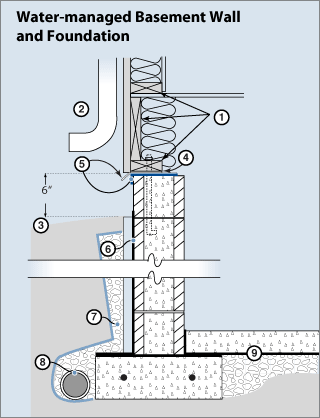To effectively insulate your
basement for energy efficiency and to create a comfortable space, you
need to properly control moisture in your basement.
Most basement water leakage results from either bulk moisture leaks or capillary
action. Bulk moisture is the flow of water through holes, cracks, and other
discontinuities into the home's basement walls. Capillary action occurs
when water wicks into the cracks and pores of porous building materials,
such as masonry blocks, concrete, or wood. These tiny cracks and pores can
absorb water in any direction – even upward.
The best approaches for preventing these problems will depend on your local
climate, type of insulation,
and style of construction. However, the following general rules apply to
most basement designs for creating a water-managed foundation system (see
corresponding illustration):
Keep all untreated wood materials away from earth contact.
Provide drainage, such as gutters, to conduct rainwater away from
the house.
Slope the earth away from all sides of the house for at least 5 feet
at a minimum 5% grade (3 inches in 5 feet). Establish drainage swales
to direct rainwater around.
Add a sill gasket to provide air
sealing.
Install a protective membrane, such as caulked metal flashing or
EPDM-type membrane, to serve as a capillary break that reduces wicking
of water up from the masonry foundation wall. This membrane can also
serve as a termite shield on top of foam
board insulation.
Damp-proof all below-grade portions of the foundation wall and footing
to prevent the wall from absorbing ground moisture by capillary action.
Place a continuous drainage plane over the damp-proofing or exterior
insulation to channel water to the foundation drain and relieve hydrostatic
pressure. Drainage plane materials include special drainage mats,
high-density fiberglass
insulation products, and washed gravel. All drainage planes should
be protected with a filter fabric to prevent dirt from clogging the
intentional gaps in the drainage material.
Install a foundation drain directly below the drainage plane and
beside the footing, not on top of the footing. This prevents water
from flowing against the seam between the footing and the foundation
wall. Surround a perforated 4-inch plastic drainpipe with gravel and
wrap both with filter fabric.
Underneath the basement's slab floor, install a capillary break and vapor diffusion retarder,
consisting of a layer of 6- to 10-mil polyethylene over at least 4
inches of gravel.
Consult a qualified builder, basement designer, and/or insulation contractor
in your area for specific basement moisture control measures concerning
your climate, type of insulation, and construction style.

